Thoroughly analyzing AP Inter 2nd Year Physics Model Papers and AP Inter 2nd Year Physics Question Paper March 2018 helps students identify their strengths and weaknesses.
AP Inter 2nd Year Physics Question Paper March 2018
Time: 3 Hours
Maximum Marks: 60
Section – A (10 × 2 = 20)
Note :
- Answer all questions.
- Each question carries two marks.
- All are very short answer type questions.
Question 1.
Distinguish between Ammeter and Voltmeter.
Answer:
| Ammeter | Voltmeter |
| 1. It is used to measure current. | 1. It is used to measure P.D between two points. |
| 2. Resistance of an ideal Ammeter is zero. | 2. Resistance of ideal voltmeter is infinity. |
| 3. It is connected in series in the circuits. | 3. It is connected in parallel in the circuits. |
Question 2.
Classify the following materials with regard to magnetism : Manganese, Bismuth, Oxygen, Copper Answer:
(i) Manganese → Para
(ii) Bismuth → Dia
(iii) Oxygen → Para
(iv) copper → Dia
![]()
Question 3.
A small angled prism of 4° deviates a ray through 2.48°. Find the refractive index of the prism.
Answer:
A = 4°, Dm = 2.48°
Dm = A(μ – 1)
μ – 1 = \(\frac{\mathrm{D}_{\mathrm{m}}}{\mathrm{A}}=\frac{2.48}{4}\) = 0.62
μ = 1 + 0.62
μ = 1.62
Question 4.
Define magnetic declination.
Answer:
Magnetic Declination (D) : The angle between the true geographic north and the north shown by a compass needle is called magnetic declination or simply declination (D).
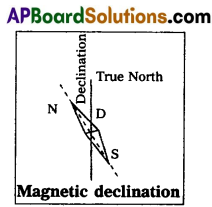
Question 5.
A transformer converts 200 V ac into 2000 V ac. Calculate the number of turns in the secondary, if the primary has 10 turns.
Answer:
\(\frac{V_s}{V_p}=\frac{N_s}{N_p}\)
Vp = 200V, Vs = 2000V, Np = 10
Ns = \(\frac{V_s}{V_p}\) × Np = \(\frac{2000}{200}\) × 10
Ns = 100.
Question 6.
What are the applications of microwaves?
Answer:
- Microwaves are used in Radars.
- Microwaves are used for cooking purposes.
- A radar using microwave can help in detecting the speed of automobile while in motion.
Question 7.
What is Photoelectric effect ?
Answer:
When light of sufficient energy is incident on the photometal surface, electrons are emitted. This phenomenon is called photoelectric effect.
Question 8.
Write down deBroglie’s relation and explain the terms there in.
Answer:
The de-Broglie wave length (λ) associated with a moving particle is related to its momentum (p) is λ = \(\frac{h}{p}=\frac{h}{m v}\), where h is planck’s constant.
Question 9.
Draw the circuit symbols for p-n-p and n-p-n transistors.
Answer:
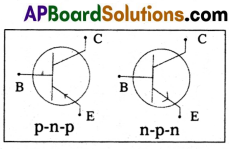
Question 10.
Define modulation. Why is it necessary ?
Answer:
Modulation : The process of combining low frequency audio signal with high frequency carrier wave is called modulation.
The audio frequency signals cannot be transmitted over long distances faithfully. Therefore they are combined with high frequency waves and transmitted.
Section – B (6 × 4 = 24)
Note :
- Answer any six of the following questions.
- Each question carries four marks.
- All are short answer type questions.
Question 11.
With a neat labelled diagram, explain the formation of image in a simple microscope.
Answer:
Simple microscope : It consists a single short focus convex lens. It increases the visual angle to see an object clearly. It is also called magnifying glass (or) reading glass.
Working : The object is adjusted within the principal focus of the convex lens to form the image at the near point. The image is formed on same side of the object and it is virtual, erect and magnified as shown in fig.
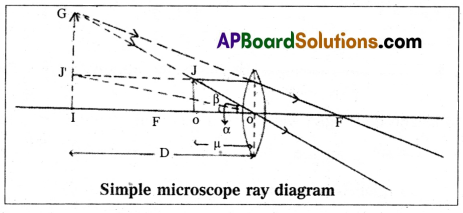
Magnifying power : The ratio of the angle subtended by the image at the eye to the angle subtended by the object at the eye is called magnifying power of a simple microscope. It is denoted by ‘m’
m = \(\frac{\alpha}{\beta}=\frac{{Tan} \alpha}{{Tan} \beta}\)
![]()
Question 12.
Derive the expression for the intensity at a point where interference of light occurs. Arrive at the conditions for maximum and zero intensity.
Answer:
Let y1 and y2 be the displacements of the two waves having same amplitude a and Φ is the phase difference between them.
y1 = a sin ωt …………. (1)
y2 = a sin (ωt + Φ) ……….. (2)
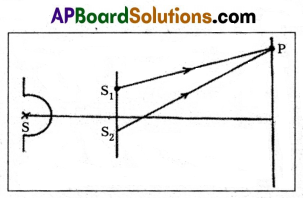
The resultant displacement y = y1 + y2
y = a sin ωt + a sin (ωt + Φ)
y = a sin ωt + a sin ωt cos Φ + a cos ω. sin Φ
y = a sin ωt [1 + cos Φ] + cos ωt (a sin Φ) ………… (3)
Let Rcos θ = a (1 + cos Φ) …………… (4)
R sin θ = a sin Φ ………..(5)
y = R sin ωt. cos θ + R cos ωt. sin θ
y = R sin (ωt + θ) …………. (6)
where R is the resultant amplitude at P squaring equations (4) and (5), then adding
R2 [cos2 θ + sin2 θ] = a2 [1 + cos2 Φ + 2 cos Φ + sin2 Φ]
R2[1] = a2 [1 + 1 + 2 cos Φ]
I = R2 = 2a2 [1 + cos Φ] = 2a2 x 2 cos2\(\frac{\phi}{2}\) ; I = 4a2 cos2\(\frac{\phi}{2}\) ……….. (7)
i) Maximum intensity (Imax)
cos2\(\frac{\phi}{2}\) = 1
Φ = 2nπ
where n = 0, 1, 2, 3 ……
Φ = 0, 2, 3 ……
∴ Imax = 4a
ii) Minimum intensity (Imin)
cos2\(\frac{\phi}{2}\) = 0
Φ = (2n + 1) π
Where n = 0, 1, 2, 3 ………
Φ = π, 3π, 5π, 7π ………
Imin = 0
Question 13.
Derive an expression for the intensity of the electric field at a point on the axial line of an electric dipole.
Answer:
Electric field at a point on the axis of a dipole:
- Consider an electric dipole consisting of two charges -q and +q separated by a distance ‘2a’ with centre ‘O’.
- We shall calculate electric field E at point P on the axial line of dipole, and at a distance OP = r.
- Let E1 and E2 be the intensities of electric field at P due to charges +q and -q respectively.
- Therefore,
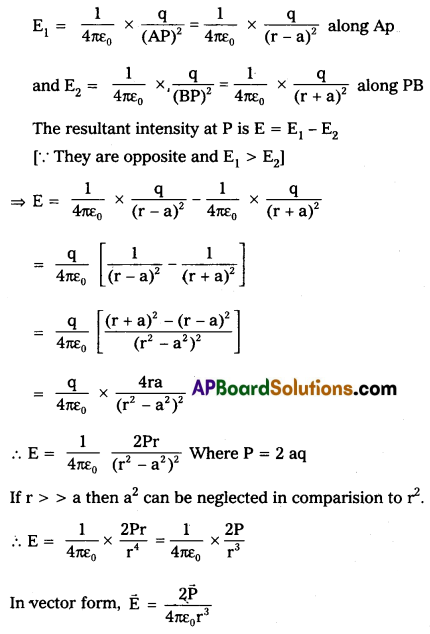
Question 14.
Derive an expression for the capacitance of a parallel plate capacitor.
Answer:
Consider two parallel plates A and B separated by a distance d in air. The upper plate A is given a charge +q and a lower plate B given a charge -q.
By using Gauss law, first we calculate the value of electric field E.

Consider a Gaussian surface PQRS. The flux through the ends PR and QS is zero, (∵ angle between E and ds is 90°). Electriflux through the surface PQ is zero, because inside the conductor charge is zero.
The only contribution of electric flux is due to the surface RS. Total electric flux through the entire Gaussian surface is
ΦE = \(\oint \mathrm{E} \cdot \mathrm{ds}=\oint \mathrm{Eds} \cos \theta\) (∵ Angle between E and dS is zero, i.e., θ = 0)
ΦE = \(\oint \mathrm{E} \cdot \mathrm{ds}\)(∵ \(\oint \mathrm{ds}\))
Let A be the area of each plate ΦE = E.A ………. (1)
Applying Gauss law ΦE = \(\frac{1}{\varepsilon_0}\)q ……… (2)
From eq’s (1) and (2), EA = \(\frac{\mathrm{q}}{\varepsilon_0}\).
E = \(\frac{q}{\varepsilon_0 A}\) ………… (3)
The potential difference V between the plates can be written as.
![]()
Question 15.
State and explain Biot-Savart Law.
Answer:
Consider a very small element of length dl of a conductor carrying current (i). Magnetic induction due to small element at a point p distance r from the element.
Magnetic induction (dfe) is directly proportional to
- current (i)
- Length of the element (dl)
- sine angle between r and dl and
- Inversely proportional to the square of the distance from small element to point P.

Question 16.
What are Eddy currents ? Describe any three uses of it.
Describe any three uses of it.
Answer:
Eddy currents are used to advantage in
i) Magnetic braking in trains : A strong magnetic field is applied across the metallic drum rotating with the axle of the electric train. Thus large eddy currents are produced in the metallic drum. These currents oppose the motion of the drum and hence the axle of the train which ultimately makes the train come to rest.
ii) Induction Motor : Eddy currents are used to rotate the short circuited rotor of an induction motor. Ceiling fans are also induction motors which run on single phase alternating current.
iii) Electromagnetic damping: Certain galvanometers have a fixed core made of non magnetic metallic material. When the coil oscillates, the eddy currents generated in the core oppose the motion and bring the coil to rest quickly.
iv) Induction furnace : Induction furnace can be used to produce high temperatures and can be utilised to prepare alloys, by melting the constituent metals. A high frequency alternating current is passed through a coil. The eddy currents generated in the metals produce high temperatures sufficient to melt it.
v) Analogue energy meters: Concept of eddy currents is used in energy meters to record the consumption of electricity. Aluminium disc used in these meters get induced due to varying magnetic field. It rotates due to eddy currents produced in it.
Question 17.
Describe Rutherford atom model. What are the draw backs of this model?
Answer:
Rutherford atom model: The essential features of Rutherford’s nuclear model of the atom or planetary model of the atom are as follows :
- Every atom consists of tiny central core, called the atomic nucleus, in which the entire positive charge and almost entire mass of the atom are concentrated.
- The size of nucleus is of the order of 10-15m, which is very small as compared to the size of the atom which is of the order of 10-10 m.
- The atomic mucleus is surrounded by certain number of electrons. As atom on the whole is electrically neutral, the total negative charge of electrons surrounding the nucleus is equal to total positive charge on the nucleus.
- These electrons revolve around the nucleus in various circular orbits as do the planets around the sun. The centripetal force required by electron for revolution in provided by the electrostatic force of attraction between the electrons and the nucleus.
Draw backs : According to classical E.M. theory.
- The revolving electron loses energy continuously, it must spiral inwards and eventually fall into the nucleus. As matter is stable, we cannot expect the atoms to collapse.
- Since the frequency of radiation emitted is the same as the frequency of revolution, the atom should radiate a continuous spectrum, but what we observe is only a line spectrum.
![]()
Question 18.
What is rectification ? Explain the working of a full – wave rectifier.
Answer:
Full wave rectifier: The process of converting an alternating current into a direct current is called rectificatioh.
The device used for this purpose is called rectifier.

- A full wave rectifier can be constructed with the help of two diodes D1 and D2.
- The secondary transformer is centre tapped at C and its ends are connected to the p regions of two diodes D1 & D2.
- The output voltage is measured across the load resistance RL.
- During positive half cycles of ac, the diode D1 is forward biased and current flows through the load resistance RL. At this time D2 will be reverse biased and will be in switch off position.
- During negative half cycles of ac, the diode D2 is forward biased and the current flows through RL. At this time D1 will be reverse biased and will be in switch off position.
- Hence positive output is obtained for all the input ac signals.
- The efficiency of a rectifier is defined as the ratio between the output dc power to the input ac power.
η = \(\frac{P_{d c}}{P_{\text {ac }}}=\frac{0.812}{r_f+R_L}\)
The maximum efficiency of a full wave rectifier is 81.2%.
Section – C (2 × 8 = 16)
Note :
- Answer any two of the following questions.
- Each question carries eight marks.
- All are long answer type questions.
Question 19.
Explain the formation of stationary waves in an air column enclosed in open pipe. Derive the equations for the frequencies ‘ of the harmonics produced. A closed organ pipe 70 cm long is sounded. If the velocity of sound is 331 m/s, what is the fundamental frequency of vibration of the air column ?
Answer:
Harmonics in open pipe: To form the first harmonic in open pipe, which has two antinodes at two ends of the pipe with anode between them.

∴ The vibrating length (l) = half of the wavelength [latex]\frac{\lambda_1}{2}[/latex]
l = \(\frac{\lambda_1}{2}\) ⇒ λ1 = 2l
Fundamental frequency v1 = \(\frac{v}{\lambda_1}\)
where v is velocity of sound in air
v1 = \(\frac{v}{2 l}\) = v ………. (1)
(ii) For second harmonic (first overtone) will have one more node and antinode than the fundamental.
If λ2 is wavelength of harmonic l = \(\frac{2 \lambda_2}{2}\) λ2 = \(\frac{2 l}{2}\)
If ‘n1’ is frequency of second harmonic then
n1 = \(\frac{\mathrm{v}}{\lambda_2}=\frac{\mathrm{v} \times 2}{2 l}\) = 2n
n1 = 2n
Similarly fof third harmonic (second overtone) will have three nodes and four antinodes as shown in above figure.
If λ3 is wave length of third harmonic l = \(\frac{3 \lambda_3}{2}\)
λ3 = \(\frac{2 l}{3}\)
If ‘n2‘ is frequency of third harmonic then
n2 = \(\frac{\mathrm{v}}{\lambda_3}=\frac{\mathrm{v} \times 3}{2 l}\) = 3n
n2 = 3n ………… (2)
Similarly we can find the.remaining or higher harmonic frequencies i.e., n3, n4 etc. can be determined in the same way.
Therefore the ratio of the harmonic frequencies in open pipe can be written as given below, n : n1 : n2 = 1 : 2 : 3 …….
Problem: l = 70 cm = 70 × 10-2 m
v = 331 m/s
n = \(\frac{\mathrm{v}}{4 l}=\frac{331}{4 \times 70 \times 10^{-2}}\)
n = \(\frac{331}{280}\) × 102 = 118.2 Hz.
![]()
Question 20.
State Kirchoff’s law for an electrical network. Using these laws deduce the condition for balance in a Wheatstone bridge. Three resistors 2Ω, 4Ω and 5Ω are combined in parallel. What is the total resistance of the combination ?
Answer:
1) Kirchoff s first law (Junction rule or KCL): The algebraic sum of the currents at any junction is zero.
∴ ΣI = 0
(or)
The sum of the currents flowing towards a junction is equal to the sum of currents away from the junction.
2) Kirchoffs second law (Loop rule or KVL) : The algebraic sum of potential around any closed loop is zero.
∴ Σ(IR) + ΣE = 0
Wheatstone bridge: Wheatstone’s bridge circuit consists of four resistances R1, R2, R3 and R4 are connected to form a closed path. A cell of emf e is connected between the point A and C arid a galvanometer is connected between the points B and D as shown in fig. The current through the various branches are indicated in the figure. The current through the galvanometer is Ig and the resistance of the galvanometer is G.
Applying Kirchhoffs first law
at the junction D, I1 – I3 – Ig = 0 ……….. (1)
at the junction B, I2 + Ig – I4 = 0 ……… (2)
⇒ Applying Kirchhoff s second law to the closed path ADBA.
– I1R1 – IgGn + I2R2 = 0
or
⇒ I1R1 + IgG – I2R2
⇒ to the closed path DCBD
– I3R3 + I4R4 + IgG = 0
⇒ I3R3 – IgG = I4R4
⇒ I3R3 – IgG = I4R4
⇒ When the galvanometer shows zero deflection the points D and B are at the same potential so Ig = 0.
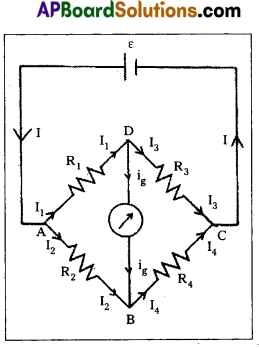
Substituting this value in (1), (2), (3) and (4).
I1 = I3 ……….. (5)
I2 = I4 ……….. (6)
I1R1 = I2R2 ……… (7)
I3R3 = I4R4 ……… (8)
⇒ Dividing (7) by (8)
\(\frac{I_1 R_1}{I_3 R_3}=\frac{I_2 R_2}{I_4 R_4}\) ⇒ \(\frac{R_1}{R_3}=\frac{R_2}{R_1}\) [∵ I1 = I3 & I2 = I4]
∴ Wheatstone’s Bridge principle :
R4 = R3 × \(\frac{R_2}{R_1}\)
Problem : R1 = 2Ω, R2 = 4Ω and R3 = 5Ω
\(\frac{1}{R}=\frac{1}{R_1}+\frac{1}{R_2}+\frac{1}{R_3}\)
\(\frac{1}{\mathrm{R}}=\frac{1}{2}+\frac{1}{4}+\frac{1}{5}\)
\(\frac{1}{R}=\frac{10+5+4}{20}=\frac{19}{20}\)
R = \(\frac{20}{19}\) = 1.05 Ω
![]()
Question 21.
Explain the principle and working of a Nuclear reactor with the help of a labelled diagram.
Answer:
Principle : A nuclear reactor works on the principle of achieving controlled chain reaction in natural Uranium 238U enriched with 235U, consequently generating large amounts of heat.
A nuclear reactor consists of 1) Fuel 2) Moderator 3) Control rods 4) Radiation shielding 5) Coolant.
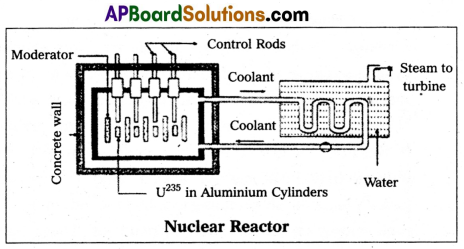
1) Fuel and clad : In reactor the nuclear fuel is fabricated in the form of thin and long cylindrical rods. These group of rods treated as a fuel assembly. These rods are surrounded by coolant, which is used to transfer of heat produced in them. A part of the nuclear reactor which use to store the
nuclear fuel is called the core of the reactor. Natural uranium, enriched uranium, plutonium and uranium – 233 are used as nuclear fuels.
2) Moderator : The average energy of neutrons released in fission process is 2 MeV They are used to slow down the velocity of neutrons. Heavy water or graphite are used as moderating materials in reactor.
3) Control Rods : These are used to control the fission rate in reactor by absorbing the neutrons. Cadmium and boron are used as controlling the neutrons, in the form of rods.
4) Shielding: During fission reaction beta and gamma rays are emitted in addition to neutrons. Suitable shielding such as steel, lead, concrete etc., are provided around the reactor to absorb and reduce the intensity of radiations to such low levels that do not harm the operating personnel.
5) Coolant: The heat generated in fuel elements is removed by using a suitable coolant to flow around them. The coolants used are water at high pressures, molten sodium etc.
Working : Uranium fuel rods are placed in the aluminium cylinders. The graphite moderator is placed in between the fuel cylinders. To control the number of neutrons, a number of control rods of cadmium or beryllium or boron are placed in the holes of graphite block. When a few 235U nuclei undergo fission fast neutrons are liberated. These neutrons pass through the surrounding graphite moderator and loose their energy to become thermal neutrons. These thermal neutrons are captured by 235U. The heat generated here is used for heating suitable coolants which in turn heat water and there by drive a generator of production for electric power.